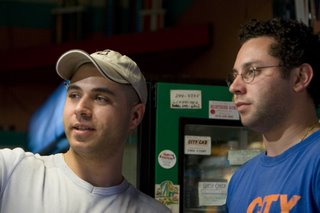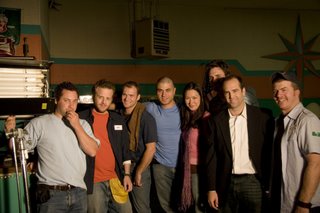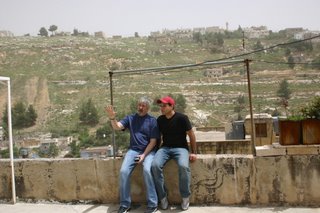On Making "Two Ends"


So I want to talk a little bit about making our new film, "Two Ends". One of the things that's always interesting with these AFI films is how diverse our teams are. On this one, you have a Jordanian director/co-writer, an Australian co-writer, a Norwegian cinematographer, and Americans for Producer and Editor, all to make a Hollywood-style romantic drama.
For me, one of my favorite themes deals with dreams. I mean having a dream as a kid, and growing up to reflect back and see where you are in life relative to what you always thought you would be doing. So this movie is about a guy and a girl who once had a dream when they were little, and were in love, but went their separate ways in life. Twenty years later, they run into each other at a bowling alley. He recognizes her, she doesn't recognize him.
I love the filmmaking process. I want to reflect back on the evolution of this film (pretty much this is how something good can come out of a collaboration). Let's start with the writing.
In writing this film, Steve Douglas-Craig (the funny Aussie) and I sat down and discussed a bunch of ideas we had. I wanted to make a movie about a boy who thought that one day he will fly like Superman, but then grows up and realizes that reality doesn't work that way. I also wanted to explore another option, which is the story of a boy who's searching for Superman, in the end we learn he's looking for him so that he can end the war abroad and get his father back from the army. It was a combination of an idea I had for a film and an artcile I'd read in the newspaper about kids and their parents being in the war overseas in Iraq.
So I wrote the first ten pages and gave them to Steve who wrote the next 13. We ended up with an epic cycle film 23 pages long. Something impossible to shoot in the four days we have to make these babies. So we went back to the drwing board and started over again. In that draft, Steve had a scene in the end that took place at a bowling alley. He said he always wanted to make a movie in a bowling alley.
So the next thing we did, we brainstormed all over again and said okay, what can we do now? How about Beauty and the Beast at a bowling alley. We got really excited about that idea. A strange combination of characters and setting. Something along those lines. So we wrote it. Steve wrote the whole thing and I read it and loved it. A few days later I started scratching my head thinking, well, maybe it's a bit overdramatic and I wanted my cycle 3 film to be more realistic than my goofy cycles one and two. So I took what steve wrote and started over from scratch with a whole new idea taking place at the bowling alley. I moved the character from living behind the pin machines in the dark to being just a miserable guy working the machines and hanging out around the bar. I love miserable characters. They're in all three of my films. I don't know why.
So anyway, I gave Steve what I wrote and he colored the dialogue and changed some scenes and gave it back to me and I made some revisions and gave it back to him, and we just had a super working relationship, never being upset for making changes in each other's work. Never clinging onto an idea if it was disposable.
So then my wonderful Producer Ryan Canon comes in and builds the team of crew memebers, finds a bunch of bowling alleys to shoot in, makes deals with locations... etc. The next thing we know, our location falls through becaus eMTV shoots there the weekend before our shoot and upsets the owner with how careless they were with the location. So Ryan hunts down a new location, he schedules the crew... etc. Then Viggo (the cinematographer) and I get together with the actors and do rehearsals. We read through the scenes and design the visual ideas for the movie. The progression of the visual style to depict the emotional state of the characters. I did something I hadn't done for my movies before. Instead of storyboarding, which I have been getting away from ever since Obsession (cycle 1), I did video-storyboards. Videotape the rehearsals from the angles that might best serve the scenes. From now on, videoboarding will be the method to prepare for my movies. I found it to be a very effective tool to capture the space and feeling of the scenes. Also, it's a lot more fun and dynamic than drawing every stupid frame of the movie by hand.
So that day we were able to figure out our shot list. But what I especially enjoyed about this experience was that we kept ourselves open to shooting scenes from different angles, and if something wasn't necessary because we captured it in a specific angle, we just scrapped it and moved on. I had a great time working with Viggo, someone who is very comfortable with improvising.
So for those who would like to know the standard procedure of shooting. First we block out the scene with the actors. I let them play the scene out while I watch. They always have something interesting to bring to the scene. I really love watching actors bring certain life to their characters. Then I make modification to the blocking. I say "okay, instead of walking here, how about if you turn around and stop there, then you look at her." Something like that. It makes a huge difference what the order of the actions is. One of my teachers once said that directing is like scuplpting with bodies. The way you position them and move them is what will allow the emotion of the scene to come out. So for example, I had one scene where the jerk boyfriend and the girl are arguing while our miserable hero was walking away from them towards the camera at the end of the bowling alley. I wanted the fight to happen in the background out of focus. So I watched them fight. Something was missing. So I found a prop. A basket of chips. I had him shove it towards her and had her push it out of the way, thus having the chips fly up everywhere. It worked out great. Here we are as an audience, as we're looking at John walk towards us, the chips fly up in the air in the background with the fight. Props are a real fun and sometimes invaluable tool to enhance a performance and make it look more real.
Anyway, so we block out the scene, figure out where the camera is going to be placed. I let the cinematographer and gaffer light the scene, then when they're ready, we bring back the actors and tweak the details. One last rehearsal for camera and focus. If everything feels right, we let the actors get their emotions and we roll action. Ideally, you get the scene in two or three takes. No more. But sometimes you have complicated dolly or jib shots that need more time and takes to get right.
Anyway, so now we're up to the editing phase. I gave my editor Scott some music I had in mind to give him a sense of the rhythm for the scenes. He found that to be a great tool to get the tone I was going for.
So there you go, the filmmaking process. It's been a great collaboration.



